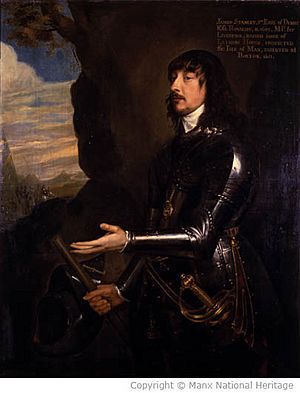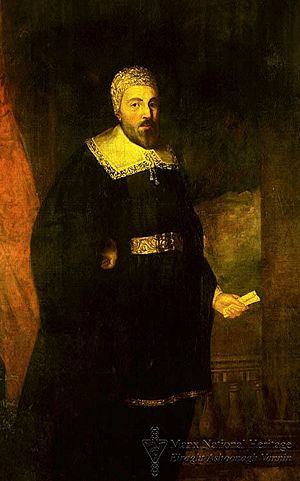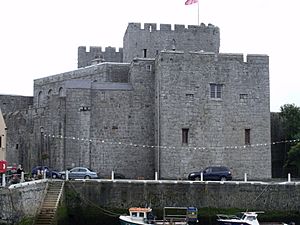Manx Rebellion of 1651 facts for kids
Quick facts for kids The Manx Rebellion of 1651 |
|||||||
|---|---|---|---|---|---|---|---|
|
|||||||
| Belligerents | |||||||
|
Manx Militia Parliamentarians |
Earl of Derby | ||||||
The Manx Rebellion of 1651 was a revolt on the Isle of Man during the English Civil War. It was led by a man named William Christian, often called Illiam Dhone, which means "Brown William" because of his dark hair.
This uprising happened mainly because of new rules about land ownership and farming that were put in place by the island's ruler, James Stanley, 7th Earl of Derby. These changes made life harder for the Manx people, who were already struggling because of the Civil War. The rebellion was a peaceful takeover, with English Parliament forces gaining control of the island without a fight. It temporarily ended the Stanley family's rule over the Isle of Man until King Charles II returned to power in England.
Contents
Why the Rebellion Started

James Stanley, the ruler of the Isle of Man, needed money to help the Royalist side in the English Civil War. In the 1640s, he tried to get more money by changing the laws about how land was owned and passed down on the island.
These changes affected an old system called the tenure of the straw. Under this system, people could own their land forever and pass it to their children without needing the Earl's permission. Stanley wanted to get rid of this system because he felt that "men think their dwellings are their own ancient inheritances, and... dispose thereof without license of the Lord." These new rules made things much harder for the Manx people, who were already facing tough times. Because of his growing power, Stanley became known as Yn Stanlagh Mooar (the Great Stanley) in the Manx language.
People on the island were not happy with these changes. There were even rumors of a possible revolt. This made Stanley return to the Isle of Man in 1643 to show his authority. Edward Christian, a relative of Illiam Dhone and a former Governor, was put in prison for planning against the Stanley family.
Another important person who opposed the changes was Ewan Christian, who was Illiam Dhone's father. Ewan Christian was a very important politician on the Isle of Man. He served as a deemster (a judge) for 51 years and was also the Deputy-Governor from 1634 to 1637. Stanley threatened to take away the Christian family's property. So, in 1643, Ewan Christian gave his property to his third son, Illiam Dhone. It was at this property that Dhone and the island's local army decided to rebel.
The Rebellion Begins
In 1648, the Earl of Derby made Illiam Dhone the Receiver General of the Isle of Man. The Earl left the island in August 1651 to fight with Charles II's armies against the Parliamentarians. His wife, Charlotte Stanley, Countess of Derby, stayed at their home, Castle Rushen. Dhone was put in charge of protecting her and her children. The Earl also gave his wife the power to act for him while he was away. Most importantly, Stanley left the island's local army under Dhone's command.
Surrender Offer
The Earl of Derby was captured during the Battle of Worcester in September 1651. In his last letter to his wife in October, he told her to try and get him released and to keep their family safe. He advised her to talk to the winning Parliamentarians about giving up the island. He wrote that it would be too hard to resist the forces that now controlled England, Scotland, and Ireland. He told her to make a deal for herself, her children, and the people on the island so they could go somewhere safe.
The Governor of the Isle of Man, Sir Philip Musgrave, helped create these surrender plans with members of the House of Keys (the island's parliament). The Countess sent these plans to Colonel Robert Duckenfield. However, these efforts failed, and Stanley was executed on October 15.
The Uprising
While the Countess was talking with the Parliamentarians, Dhone was also secretly negotiating with them.
Many important Manxmen knew about the Countess's plans to surrender. They worried that she would save herself by making a bad deal for the Manx people. Because the Earl was captured, there was no clear leader. People were also still upset about the land ownership changes. So, a revolt against the Stanley family's rule was planned.
Dhone and Musgrave pretended to agree to defend the island from invasion until good terms were met. But in truth, the Parliamentarians were getting ready to attack the island. This agreement was just a way for Dhone and the Manx army to gain time. On the same night that the surrender offer was sent, Dhone led a rebellion against Stanley's rule.
Dhone, as the commander of the local army, called on the Captains of the Parishes (local leaders) to rise up and take control of the important forts along the coast. About 800 men gathered. The Manx army successfully took the smaller forts but could not capture the largest castles at Peel and Rushen.
After a delay due to a storm, Colonel Robert Duckenfield and his invasion fleet landed on the island at the end of October. Dhone and the Manx army worked with them and allowed the Parliamentarian forces to take control of the island. This happened on the condition that the "ancient rights and laws" that James Stanley had tried to change would be brought back.
The Countess did not find out about her husband's death until late October. In a letter she received from Colonel Duckenfield dated October 29, 1651, she refused to surrender. She explained that she would not give up the island without orders from her husband, as it was her duty to obey him.
However, by November 3, the Countess realized that her soldiers could not be trusted to hold the forts. She surrendered on the condition that she, her children, and her servants could safely travel to England and then to another safe place. This meant the Parliamentary forces took control of the Isle of Man without any fighting.
What Happened Next
Illiam Dhone remained the Receiver General of the Isle of Man after the rebellion. He later became the Governor of the Isle of Man in 1656. Dhone was eventually punished for his part in the rebellion. He was accused of misusing money meant for charity while he was Governor and Receiver General. He fled to London and was arrested in 1660.
He was released the next year and returned to the Isle of Man. He hoped that his actions in the rebellion would be forgiven under a law called the Indemnity and Oblivion Act of 1661, which was part of King Charles II's return to power. However, Charles Stanley, 8th Earl of Derby, the eldest son of James Stanley, ordered Dhone's arrest. He called the rebellion "a most heinous sin against God."
At Dhone's trial, many members of the House of Keys did not want to find him guilty. So, they were removed and replaced with others who would convict him. Even though the Act of Indemnity was supposed to protect people from punishment for past actions during the Civil War, Dhone was found guilty. He was executed by a firing squad at Hango Hill near Castletown on January 2, 1663.
Legacy
The Manx Rebellion, and especially Illiam Dhone's death, became very important for Manx nationalism in the 1900s. Today, a Manx Nationalist party called Mec Vannin holds a yearly event at the place where he was executed to remember him.



